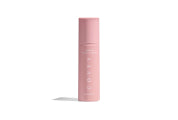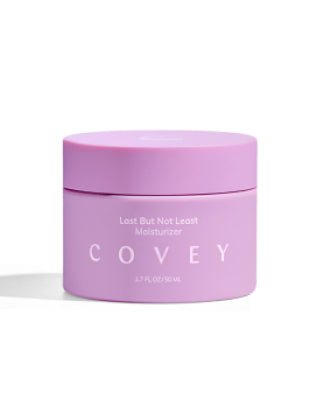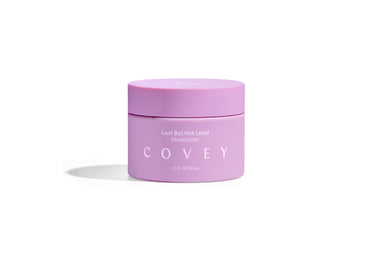
The Covey Summer Sunscreen Buying Guide: What To Look for In a Sunscreen
With warmer weather, beach days, and sunny Summer Fridays ahead come every skincare fanatic’s nightmare — the fear of sun-induced hyperpigmentation, age spots, and dry, peeling sunburnt skin. Luckily, there’s more information about the power (and benefits!) of sunscreen than ever before. We’re not slathering on baby oil these days or hitting the tanning bed like we used to.
Today, sun care is a multi-billion dollar industry and choosing a great sunscreen can feel overwhelming. There are a ton of elements to consider, from SPF to ingredients to mineral vs. chemical formulas. Wearability matters too; you’ll want to avoid sunscreens that irritate your eyes. Ultimately, the right sunscreen for you is the one you’ll reach for again and again, day in and day out.
So, what should you look for in a summer sunscreen? Here’s how to choose a sunscreen your skin will love:
Sunscreen Ingredients to Look For
When choosing a sunscreen, you’ll see formulas fall into two camps: mineral versus chemical sunscreens.
Mineral Sunscreens: Zinc Oxide and Titanium Dioxide
Mineral sunscreens will typically have zinc oxide or titanium dioxide. How mineral sunscreens work is that they sit on top of the skin in order to block rays from absorbing in the first place. Typically, mineral sunscreens are thought of as having more of a white cast than chemical ones, but it depends on the rest of the product's ingredients.
Zinc acts as a physical shield against UV rays, and offers better stability. Zinc oxide also tends to be the hero ingredient in formulas with less (or lower) amounts of white cast. This makes it a top contender for darker skin tones. Zinc also helps fight discoloration, fine lines, and dark spots caused by sun exposure.
Mineral sunscreens can sometimes be less sheer and a thicker consistency than their chemical counterparts, but they are specifically recommended for sensitive or acne-prone skin.Chemical Sunscreens: Oxybenzone or Avobenzone
In contrast, chemical sunscreen work differently by absorbing into the skin and turning UV rays into heat. They're typically formulated with chemical ingredients like oxybenzone, octinoxate, and avobenzone.
The primary benefit of chemical sunscreens is that they're lightweight, sheer, and absorb easily into the skin, so some people love using a chemical sunscreen for every day and a mineral one for high-impact sun days (like going to the beach).
However, chemical sunscreens can be irritating to sensitive skin types and if you have rosacea or melasma, chemical sunscreens can worsen those symptoms.
Hydrating Ingredients to Look for
When you're out in the sun on a regular basis, your skin loses moisture and elasticity the longer it's exposed to harmful UV radiation. You'll want to replace the lost moisture with hydrating ingredients in your sunscreen. Look for squalane, ceramides, hyaluronic acid, or glycerin.
Ingredients to Avoid
You'll want to skip sunscreens that contain parabens, sulfates, and silicon (which can be pore-clogging for some skin types). Fragrances can also be irritating, specifically to sensitive skin types. We know the coconut sunscreens smell amazing, but consider your own skin's sensitivity before making that your daily lotion.
How to Know What SPF to Use
It’s important to know what levels of SPF allow for max protection from UV radiation. General wisdom (according to the American Academy of Dermatology) states that most people should use a minimum of SPF 30, which protects against roughly 96.7% of UV radiation.
You may want to up your SPF to ensure maximum protection. For example, a broad-spectrum SPF 50+ (reapplied every two hours, but generally follow the instructions on your sunscreen bottle) typically shields the skin from 98%+ of UV radiation.
However, most people aren’t wearing enough sunscreen. “Typical users of sunscreens get only 20% to 50% of the protection suggested by the label on the bottle,” reports the Journal of the American Academy of Dermatology. How much sunscreen you wear daily directly impacts your level of protection, so if you’re only applying once or aren’t consistent, a higher SPF can help you stay more protected from UV rays.
Wearability and Versatility
Sunscreen can sometimes feel heavy or greasy, which can make it difficult to apply makeup on top. Other sunscreens start to pill once you apply makeup, so you won’t have a flawless base as a starting point for your look.
Instead, look for sunscreens that are lightweight, non-greasy, and absorb quickly into the skin. Some sunscreens are specifically formulated to be worn under makeup, but sometimes have lower SPFs, so keep an eye out for that.
When choosing a daily sunscreen, you want it to be versatile enough to wear under makeup or be strong enough for a spontaneous trip to the beach. You never know what a summer day might hold!
The Wrap Up
Choosing a sunscreen comes down to your preferences — how it wears under makeup, if it causes eye irritation or breakouts, and how likely you are to reapply are all big considerations while you sunscreen shop.
When in doubt, opt for a SPF 50+ formulation and apply two fingers lengths (minimum) to the face and decolletage. Don’t feel too swayed by trends in the sunscreen industry. Remember, the best sunscreen for you is the one you’ll use!
















